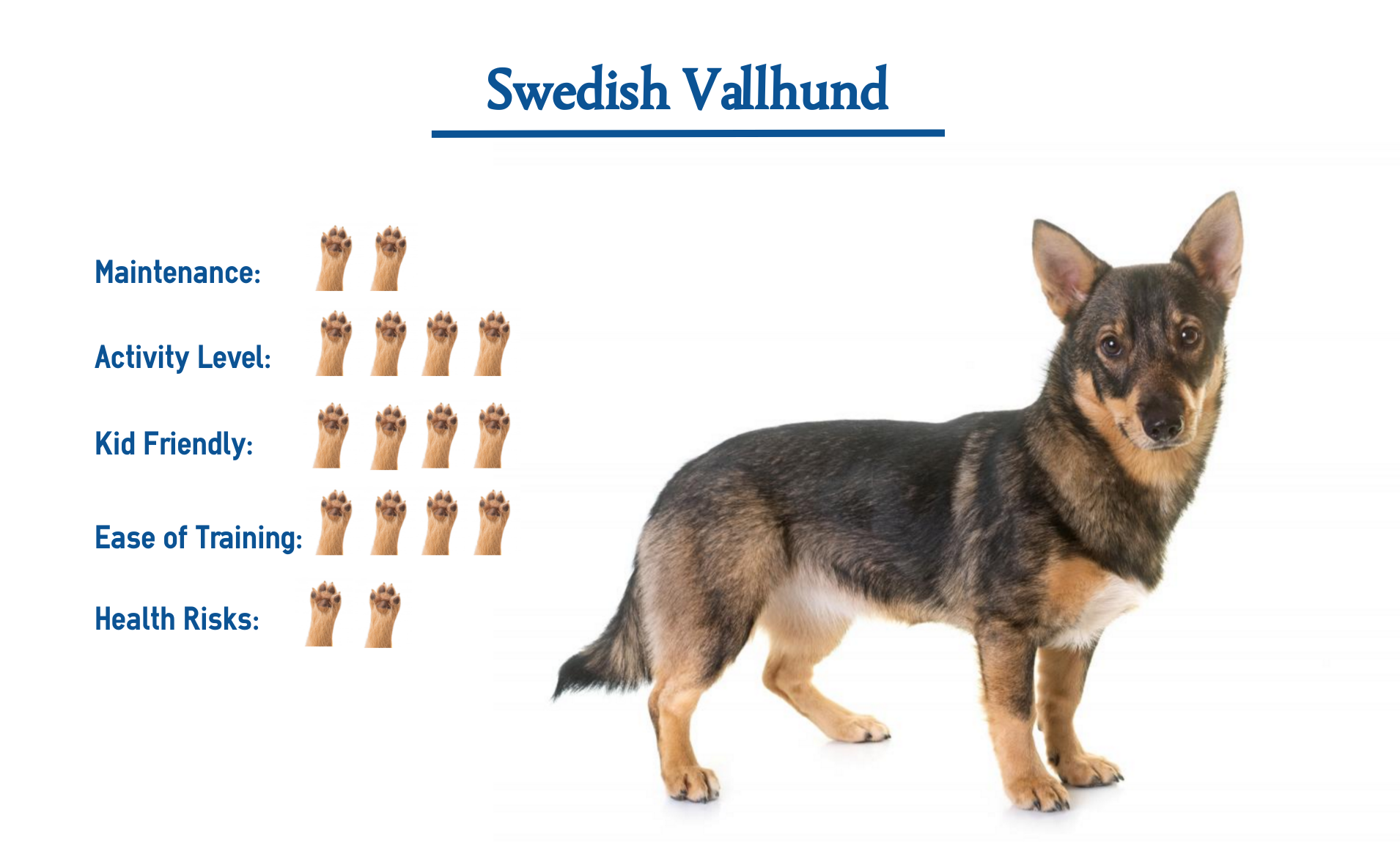While the Swedes are among the tallest people in the world, you should know that the Swedish Vallhund isn’t going to live up to his human stereotype. But don’t fret because this short-legged dog is a cutie, and even though he may often be confused for a Corgi, this little cutie from the North is 100% Swed and an animal that many people should consider getting as a pet.
But is the…
Swedish Vallhund the “right” dog breed for you? That’s the “million dollar” question we hope to help you answer after reading this article. Because the last thing that we here at IndulgeYourPet would want to see happen is for you to adopt a Swedish Vallhund puppy only to determine later that this incredible little dog isn’t right for you.
So, without further ado, let’s dive right in!
Fast Facts about Swedish Vallhunds
Country of Origin: Sweden
Original Purpose: Herding dog
Height: 11 to 13 inches at the shoulder (roughly 1 foot tall)
Weight: 20 to 35 pounds (best kept at 20-30)
Dog Breed Classification: Herding group
Other Names: Vastogotaspets, Swedish Cow Dog, Swedish Shepherd, Swedish Cattle Dogs
Lifespan: 11-15 years
Origin of the Swedish Vallhund Dog Breed
While people sometimes refer to them as a Viking dog, that’s technically inaccurate. The Vikings were around way earlier than the Vallhund, who only probably came into existence in the late 1800s or early 1900s. But, as you probably know, when most people think of Scandinavia, they think of Vikings, so it’s easy to understand why there’s this confusion about these little guys.
After all…
Wouldn’t it be cool to own a dog from the Viking era? It would… but this isn’t the one! And don’t confuse the name Vallhund with Valhalla, the Viking name for heaven, because while Vallhund may seem similar, it’s the Swedish word for “herding,” which makes much more sense when you think about it.
Now before…
1943, these dogs weren’t all that popular; yep, during World War 2, they had time to recognize new dog breeds! Strange, isn’t it?), however, right around this time, they began gaining recognition from the Swedish Kennel Club. During this time, two Swedish breeders by the names of Bjorn von Rosen and K. G. Zettersten really started getting the Vallhund dog breed the recognition it deserved. However, these little guys still didn’t become popular here in the United States even after the American Kennel Club (AKC) finally decided to recognize the breed in 2007.
Physical Characteristics
Of course, you’ll first notice that these guys have short legs and a broad chest. Technically, they are medium-sized dogs, but their little legs make them look not so tall and a bit small (and cute!). These tiny legs are also why folks often mistakenly identify these little guys as Pembroke Welsh Corgi, but they aren’t related.
Swedish Vallhund dogs also…
Have medium-length double-coat hair. Like most dogs bred for harsher conditions, the top is rough, and the undercoat is soft. You’ll find lighter hair highlighting the eyes and muzzle, but some darker colors of grey, red, and brown on the body and back. They have a variety of tail types: long and bushy or bobbed and stubby. Their ears stand upright and are pointy.
Grooming
You’ll need to remove dead hair regularly by brushing once a week. You should touch the brush to the skin (of course, not roughly). This will help with gland stimulation Swedish Vallhund, so your pup can produce necessary oils.
Personality and Temperament
As a working dog, this guy is confident and stands tall (for his height!). He’s free-spirited but loyal. He’s not quiet; he’ll bark to talk with you. Training a Swedish Vallhund puppy is essential; don’t wait until later in life. These intelligent dogs like a challenge, so puppy school will be fun rather than a pain. Even after training, puppies and an adult dog will love mental stimulation – your Swedish Vallhund must live a healthy life.
Potential Health Concerns
Unlike other breeds, this dog doesn’t have many inherent health problems, mainly if you use a good breeder. If you buy one, choose only from breeders recommended by the American Kennel Club or another reputable dog organization that recognizes.
Of course, your dog could still have a health problem even if you use the best breeder. The most common health problems for Swedish Vallhunds are:
- Progressive Retinal Atrophy,
- Hip Dysplasia.
If your dog has either of these problems, it may need surgery, which can be costly. You may be able to identify either of these problems when the dog is a puppy, but only sometimes. Progressive retinal atrophy could result in total blindness if left untreated.
Other Health Issues
In addition to this, like any dog, your Vallhund could have an accident or contract a disease. If he does, you must do whatever treatment is necessary. Trying to estimate the total expenses of raising a Swedish Cow Dog is impossible since many things could go wrong in his lifetime.
And while…
Many of these conditions may not be life-threatening, but they can become quite expensive, particularly if they become recurring issues. This is why we here at IndulgeYourPet also recommend that any new pet owner take a moment and see what it might cost for you to purchase a pet insurance policy for your new animal.
Now will a pet insurance policy be suitable for everyone?
No, probably not. But until you fully understand what these policies “will” and “won’t” cover and how much these pet insurance policies cost, how will you know if one might be right for you?
For more information on who we feel currently offers the “best” pet insurance policies out there, we would encourage you to check out our Best Pet Insurance Policies article.



